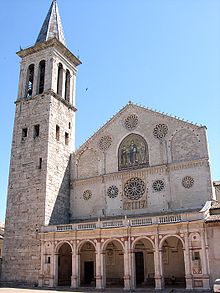Archbishop of Spoleto
|
Archdiocese of Spoleto-Norcia Archidioecesis Spoletana-Nursina |
|
|---|---|

Spoleto Cathedral
|
|
| Location | |
| Country | Italy |
| Ecclesiastical province | Immediately subject to the Holy See |
| Statistics | |
| Area | 1,836 km2 (709 sq mi) |
| Population - Total - Catholics |
(as of 2010) 104,215 101,750 (97.6%) |
| Parishes | 76 |
| Information | |
| Denomination | Catholic Church |
| Rite | Roman Rite |
| Established | 1st century |
| Cathedral | Cattedrale di S. Maria Assunta (Spoleto) |
| Co-cathedral | Concattedrale di S. Maria Argentea (Norcia) |
| Current leadership | |
| Pope | Francis |
| Archbishop | Renato Boccardo |
| Website | |
| www.arcidiocesidispoletonorcia.it | |
The Italian Catholic Archdiocese of Spoleto-Norcia (Latin: Archidioecesis Spoletana-Nursina), historically the Diocese of Spoleto, and an archdiocese since 1821, is directly subject to the Holy See.
Spoleto, the Roman Spoletium, surrendered in the Gothic war (537) to the Byzantine general, Constantine; but in 546 it was recovered by Totila, and it was not retaken by the Byzantines until 552, when Narses restored the fortifications. In 572 Spoleto became the seat of a Lombard duke, Faroald.
Under Hildebrand, the Duchy of Spoleto was promised to the Holy See by the King of the Franks, and the duke himself was named by Pope Adrian (773), but the succeeding dukes were named by the Frankish emperors. Winigisus aided Pope Leo III against his enemies.
Duke Lambert distinguished himself in the wars against the Saracens, but disgraced himself by at Rome in 867; he was afterwards deposed (871), then restored (876), but was a second time excommunicated by Pope John VIII. In 883 Guido II of Spoleto united under his sway the entire dukedom, which from this time was called the Duchy of Spoleto and Camerino. After the death of Charles the Fat (888), Guido had himself crowned Roman Emperor and King of Italy under Pope Stephen V (891); Pope Formosus in 892 also crowned his son Lambert II, who succeeded his father in the dukedom, kingdom, and empire.
Alberico I, Duke of Camerino (897), and afterwards of Spoleto, married the notorious Marozia; he was killed by the Romans in 924. His son Alberico II made himself also master of Rome and remained there until the election to the papacy of his son John XII.
...
Wikipedia
